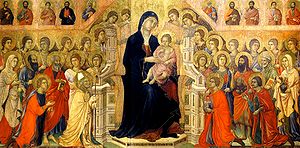|
Maestà (Duccio)
The Maestà, or Maestà of Duccio, is an altarpiece composed of many individual paintings commissioned by the city of Siena in Tuscany in 1308 from the artist Duccio di Buoninsegna[1] and is his most famous work.[2] Duccio's the Maestà was originally composed with a front and back side that relied on each other to encompass the full knowledge of the altarpiece. This was the first altarpiece to contain both a front and back side.[3] The front panels make up a large enthroned Madonna and Child with saints and angels, and a predella of the Childhood of Christ with prophets. The reverse has the rest of a combined cycle of the Life of the Virgin and the Life of Christ in a total of forty-three small scenes; several panels are now dispersed or lost. The base of the panel has an inscription that reads (in translation): "Holy Mother of God, be thou the cause of peace for Siena and life to Duccio because he painted thee thus."[4] Though it took a generation for its effect to be truly felt, Duccio's Maestà set Italian painting on a course leading away from the hieratic representations of the Italo-Byzantine style towards more direct presentations of reality, as developed in the rest of the Trecento. HistoryDuccio di Buoninsegna painted the work with assistants in a studio located on Via Stalloreggi, very close to Siena Cathedral. The painting was installed in the cathedral on 9 June 1311 after a procession of the work in a loop around the city. One person who witnessed this event wrote:
Besides the Virgin Mary and the Baby Jesus, saints depicted in the painting include John the Evangelist (to the left of the throne); Saint Paul; Catherine of Alexandria; John the Baptist (to the right of the throne); Saint Peter; Mary Magdalene, and Saint Agnes.[5] In the foreground are Siena's various patron saints: Saint Ansanus; Saint Sabinus; Saint Crescentius; and Saint Victor.[5] Creating this altarpiece assembled from many wood panels bonded together before painting was an arduous undertaking. The work was not only large, the central panel was 7 by 13 feet, but it had to be painted on both sides since it could be seen from all directions when installed on the main altar at the centre of the sanctuary.[4] Dismantling and current locationsThe altarpiece remained in place until 1771, when it was dismantled in order to distribute the pieces between two altars. The 5-metre-high (16 ft) construction was dismantled and sawn up, and the paintings damaged in the process. Partial restoration took place in 1956. The dismantling also led to pieces going astray, either being sold or simply unaccounted for. Extant remains of the altarpiece not at Siena are divided among several other museums in Europe and the United States. The panels in Siena are housed in the Duomo museum adjacent to the Duomo di Siena. The central panel, lower panels, and rear are displayed separately in the same room. Stylistic analysisChrist's followers, Joseph and John, remove him from the cross while Nicodemus removes nails from his feet. The Virgin Mary looks into his closed eyes while Mary Magdalene holds his arm, and all have painful expressions as they tend to the dead Christ. The background has the same gold texture as in the "Crucifixion" and the cross that held Christ has blood running onto the ground, increasing the sense of realism in the scene. This panel aroused the emotions of its audiences and the story helped to symbolize the birth of Christianity.
Immediately following the "Deposition" is the depiction of Christ as he is prepared for burial, surrounded by his mourning followers. His mother leans in close to him and kisses him one last time and Mary Magdalene throws her arms towards the sky in anguish. The background retains the gold setting of the "Deposition" and "Crucifixion," and the mountains in the background are similar to the mountains portrayed in previous and subsequent panels. These mountains lead the viewer's eye to Mary, who is accompanying him, and then to Christ's face. This scene also elicits an intense emotional response from its viewers and you can see the close connection that the burial party has to Christ, and especially to the Virgin Mary. List of panels in the worldIn Siena 
ElsewhereEurope
United States
See alsoReferences
Further reading
External linksWikimedia Commons has media related to Cathedral (Siena) - Maestà.
|
|||||||||||||||||||||||

